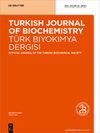马氏Buthus martensii Karsch镇痛肽的分子克隆及功能鉴定
IF 0.7
4区 生物学
Q4 BIOCHEMISTRY & MOLECULAR BIOLOGY
Turkish Journal of Biochemistry-turk Biyokimya Dergisi
Pub Date : 2013-01-01
DOI:10.5505/TJB.2013.84429
引用次数: 2
摘要
目的:从蝎端子cDNA库中克隆编码镇痛肽的基因,通过原核表达系统获得重组肽,并通过小鼠扭体实验检测其镇痛活性。材料与方法:采用巢式PCR方法,从蝎端子cDNA库中克隆出镇痛肽编码基因。阳性克隆经PCR-SSCP筛选后测序。重组肽通过大肠杆菌功能表达获得,并通过金属螯合层析纯化。小鼠扭体试验测定其生物活性。结果:获得了两个编码潜在镇痛肽的核苷酸序列。它们被命名为BmK 22和BmK 9。bmk22是一个新的多肽,在54号位点只有一个氨基酸与bmk9不同。在小鼠扭体实验中,两种重组肽均表现出镇痛活性,其中bmk9的镇痛活性更强。进一步,通过同源性建模考虑结构因素,我们推测bmk9 54位点的Arg残基可能在靶识别中发挥重要作用,影响镇痛活性。结论:蝎子毒液中含有丰富的生物活性肽。本文通过bmk9和bmk22的分子克隆、功能表达和生物活性鉴定,为发现具有特殊生物活性的蝎毒素(如镇痛药)提供了一条快速途径。本文章由计算机程序翻译,如有差异,请以英文原文为准。
Molecular cloning and functional identification of analgesic peptides from Buthus martensii Karsch
Aim: To clone genes encoding analgesic peptides from the cDNA pool of scorpion telson, to obtain recombinant peptides by prokaryotic expression system and examine their analgesic activity in mouse twisting test. Material and methods: The genes encoding analgesic peptides were cloned from the cDNA pool of scorpion telson by nested PCR. Positive clones were sequenced after screened by PCR-SSCP. The recombinant peptides were obtained by functionally expression in E. coli and purified by metal chelating chromatography. The bioactivity was assayed in mouse twisting test. Results: Two nucleotide sequences encoding potential analgesic peptides were obtained. They were named as BmK 22 and BmK 9. BmK 22 was a new peptide with only one amino acid at site 54 different with BmK 9. In mouse-twisting test, both of the two recombinant peptides exhibited analgesic activity, and BmK 9 showed a stronger activity in pain relieving. Further, when considering structure factors by homology modeling, we speculated that the Arg residue at site 54 of BmK 9 may play an important role in target recognition and influence the analgesic activity. Conclusion: Venoms from scorpions contain extremely rich bioactive peptides. The strategy in this paper involving molecular cloning, functional expression and bioactivity identification of BmK 9 and BmK 22 provided a rapid route to discover scorpion toxins with special bioactivity such as analgesics.
求助全文
通过发布文献求助,成功后即可免费获取论文全文。
去求助
来源期刊
CiteScore
1.20
自引率
0.00%
发文量
0
审稿时长
6-12 weeks
期刊介绍:
Turkish Journal of Biochemistry (TJB), official journal of Turkish Biochemical Society, is issued electronically every 2 months. The main aim of the journal is to support the research and publishing culture by ensuring that every published manuscript has an added value and thus providing international acceptance of the “readability” of the manuscripts published in the journal.

 求助内容:
求助内容: 应助结果提醒方式:
应助结果提醒方式:


